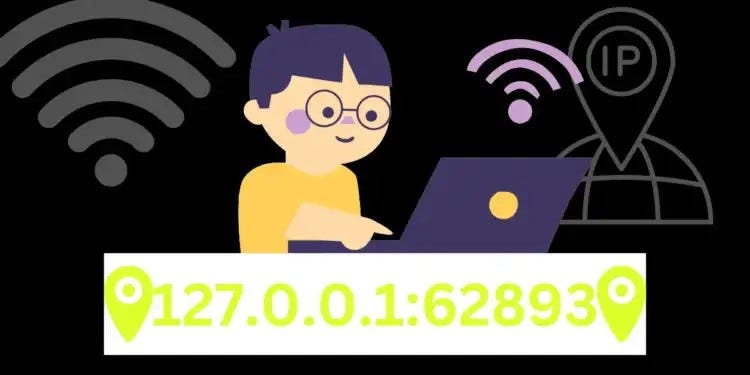I used 127.0.0.1:62893 to test a new software feature on my computer. It let me check everything worked properly before I put it live, without affecting anything else.
127.0.0.1:62893 is an address and port used locally on a computer for testing and development. It lets applications communicate internally without needing internet access. You can access it by typing “http://127.0.0.1:62893” in a web browser or using command-line tools like curl.
This blog post explains what 127.0.0.1:62893 is, how it operates, and how to resolve a typical issue related to it.
What Is 127.0.0.1:62893?

This code consists of two parts:
1. 127.0.0.1:
Localhost: 127.0.0.1 is a special IP address known as “localhost.” It acts as a loopback address that points back to your own computer. Think of it as a way for your computer to communicate with itself internally.
2. 62893:
Port Number: Ports act like doorways for different applications to send and receive data. Port 62893 is not as common as others but is sometimes used by Memcached, a caching system.
How 127.0.0.1:62893 Works?
The cryptic address 127.0.0.1:62893 works in this way:
- Internal Communication: An application on your device tries to communicate with another process.
- Localhost Destination: It specifies “localhost” (127.0.0.1) as the destination, indicating it wants to interact with something on the same machine.
- Port Specification: The port number (62893) tells the operating system which specific service or program to route the communication to.
Is It Safe To Expose Port 62893 Publicly?
Exposing port 62893 to the public is generally not safe. Doing so can make your system vulnerable to hackers who might exploit weaknesses in services like Memcached, leading to data theft or unauthorized control over your applications.
Additionally, open ports can be targeted by Denial-of-Service (DoS) attacks, where excessive traffic overwhelms and crashes your system.
What Are The Benefits Of 127.0.0.1:62893?
1. Development and Testing:
127.0.0.1:62893 provides a safe environment for developers to test applications without internet exposure, reducing the risk of external interference. It allows for isolated testing, ensuring applications run smoothly before deployment.
2. Networking:
Localhost is fundamental in networking, helping understand client-server communication and TCP/IP. It facilitates internal communication between processes on the same machine, essential for testing network applications.
3. Security:
Monitoring port activity on 127.0.0.1:62893 helps detect and prevent unauthorized access attempts, minimizing security risks during development and testing phases.
4. Debugging:
Localhost simplifies debugging by allowing developers to quickly identify network-related issues within their local setup, making troubleshooting more efficient.
5. Isolated Environment:
Using 127.0.0.1:62893 creates an isolated environment for development and testing, preventing conflicts with other applications and maintaining system stability.
6. Educational Purposes:
127.0.0.1:62893 is a valuable educational tool for learning networking and development concepts, providing hands-on experience in setting up and managing local servers.
7. Flexibility and Customization:
Developers can customize their local environment using 127.0.0.1:62893, creating versatile testing scenarios that match project requirements.
How To Fix “Disconnected From The Target Vm, Address: 127.0.0.1:62893” Error:

Here’s a simplified guide to resolve this issue:
- Check Application Status: Ensure the target application on port 62893 is running correctly.
- Verify Port Configuration: Double-check that the port number in your debugging settings matches the application’s actual port configuration.
- Firewall Settings: Check firewall settings to ensure port 62893 isn’t blocked for local connections.
- Restart Debugging: Restart your debugging session to refresh the connection attempt.
- Change Port Numbers: If issues persist, try changing the port number in your application’s settings.
- Update Software: Keep your IDE and related tools up to date for bug fixes and improvements.
- Consult Documentation: Refer to IDE documentation for specific troubleshooting steps.
- Use Network Diagnostic Tools: Check if port 62893 is in use by other applications using network diagnostic tools.
- Adjust Firewall Rules: Configure firewall exceptions to allow traffic on port 62893 for local connections.
- Seek Technical Support: If problems persist, seek assistance from developers or support forums.
What Are The Risks Of Exposing Port 62893 Publicly?
1. Security Risks:
Opening port 62893 to the public can attract hackers. If the service running on this port has weaknesses, hackers can exploit them to break into your system. This could lead to stolen data and significant harm.
2. DoS Attacks:
Port 62893 can be targeted for Denial-of-Service (DoS) attacks. Attackers might send too much traffic to this port, causing the service to crash or stop working. This can lead to service interruptions and potential loss of business.
3. Unauthorized Access:
When port 62893 is open to the internet, anyone can try to connect to it. Without strong security, this can allow unauthorized people to access your network and sensitive information. This can result in data theft and other malicious activities.
How Can You Configure Firewall Settings For 127.0.0.1:62893?
On Windows:
- Open Windows Defender Firewall:
- Press Windows + R, type control, and press Enter.
- Go to System and Security > Windows Defender Firewall.
- Click on Advanced settings on the left panel.
- Create a New Inbound Rule:
- In the Windows Defender Firewall with Advanced Security window, click on Inbound Rules in the left panel.
- Click on New Rule… in the right panel.
- Select Port:
- Choose Port and click Next.
- Specify the Port:
- Select TCP or UDP (usually TCP for most applications).
- Specify port 62893 in the Specific local ports field.
- Click Next.
- Action:
- Choose Allow the connection or Block the connection, depending on your needs.
- Click Next.
- Profile:
- Select the profiles where this rule should apply (Domain, Private, Public).
- Click Next.
- Name the Rule:
- Give your rule a name and an optional description.
- Click Finish.
Can Multiple Applications Use Port 62893 Simultaneously?

No, In computer networks, each application uses specific ports to send and receive data. Port numbers range from 0 to 65535, and only one application can use a port at a time on a computer.
If one application is already using port 62893, another application cannot use the same port and must choose a different one that is available.
This setup prevents data conflicts and ensures that each application gets the data it expects through its assigned port, keeping network communication reliable.
How To Access 127.0.0.1:62893?
- Open a web browser and type http://127.0.0.1:62893 into the address bar, then press Enter.
- Open Command Prompt on Windows and use the command curl http://127.0.0.1:62893.
- Open Terminal on Mac/Linux and use the command curl http://127.0.0.1:62893.
- Ensure the application you want to access is running on port 62893 and verify its configuration.
- Check your firewall settings to make sure traffic on port 62893 is allowed.
- Ensure your network settings permit localhost connections and check for any network restrictions.
FAQS:
1. What is the purpose of 127.0.0.1?
127.0.0.1, also known as localhost, is used to establish an IP connection to the same machine or computer being used by the end-user. It’s primarily used for testing and development.
2. Why do developers use 127.0.0.1:62893?
Developers use this address to test applications locally without exposing them to the internet. It provides a safe and controlled environment to debug and troubleshoot applications.
3. What kind of applications typically use port 62893?
Port 62893 can be used by various applications, particularly those needing local communication during development and testing, such as web servers, databases, and debugging tools.
4. How do I secure services running on 127.0.0.1:62893?
To secure services, use strong authentication methods, keep software updated, configure firewall rules, and monitor for suspicious activities. Also, avoid exposing the port to public networks if not necessary.
Conclusion:
In summary, 127.0.0.1:62893 allows developers to test applications locally without internet access. It ensures secure development and network integrity by minimizing risks and vulnerabilities.









